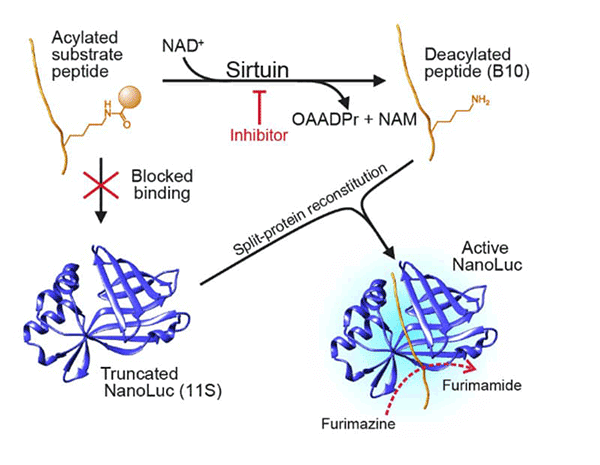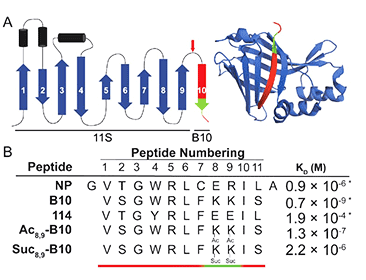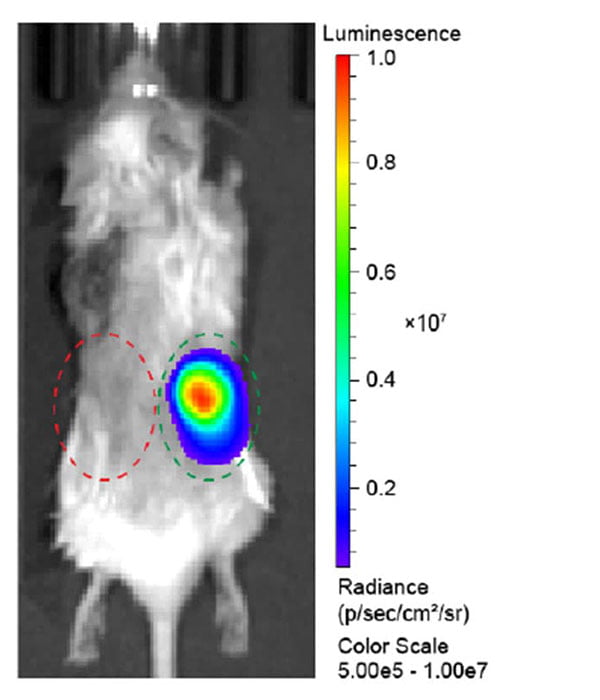A bioluminescent assay for direct measurement of sirtuin activity in cancer cells Sirtuins are nicotinamide adenine dinucleotide (NAD+)-dependent lysine deacylases that act on histones, transcription factors, epigenetic regulators and metabolic enzymes to regulate key cellular functions such as apoptosis, senescence and energy metabolism. Depending on the cellular context, sirtuins can promote or inhibit oncogenesis, defining a critical need for methods capable of interrogating sirtuin activity in intact cells and animal models. However currently available sirtuin assays are confined to cell free systems, are prone to artifacts, and have limited sensitivity and dynamic range.
 Schematic of the bioluminescent lysine deacylation assay.
Schematic of the bioluminescent lysine deacylation assay.The lack of assays that provide a reliable, direct and real-time readout of sirtuin activity in vitro and in vivo poses a major barrier to drug development and biological studies. To overcome the limitations of current assays we propose luciferase-based assay that reports in real- time sirtuin activity in cell free and cellular assays through generation of a bioluminescence signal by conversion of furimazine to furimamide. Our design is based on a split-NanoLuc complementation system that consists of a truncated catalytically inactive N-terminal moiety (termed 11S), which is activated by complementation with a high affinity 11-aa C-terminal peptide containing two lysine residues (K8,K9).
Our premise is that acylation or other modifications of the lysine residueswithin the high affinity Cterminal complementation peptide inhibit itsbinding to the N-terminal NanoLuc moiety, preventing activation; activesirtuin enzyme removes the acyl groups, allowing for luciferasecomplementation and generation of a luminescence signal. Our preliminarydata using SIRT5 enzyme demonstrate a robust reporter signal in cell freeassays and suggest that measurement of intracellular sirtuin activity isfeasible. In Aim 1 we will adapt the split-NanoLuc assay for measuringsirtuin deacylase activity in cell free systems and determine which lysinemodifications within the C-terminal complementation peptide block bindingto the large NanoLuc fragment and are removed by sirtuins 1 – 7. We willoptimize assay conditions, and delineate performance parameters(sensitivity, selectivity, dynamic range, coefficient of variation). In Aim 2 wewill adapt the split-NanoLuc assay for measurement of SIRT5 activity in livecells and in vivo. We will generate SIRT5 reporter cell lines, targeting thetruncated NanoLuc to specific cellular compartments. We will optimizeconditions for quantitative bioluminescence measurement in live cancercells and in vivo, using CRISPR/Cas9, shRNA and inhibitors to modulateSIRT5 activity. Our design has critical advantages over current approaches:(i) Potential adaptability to any type of acyl modification; (ii) High signal- tobackgroundratio; (iii) Avoidance of artifact-prone chemically modifiedprobes; (iv) Adaptability to measurement of enzyme activity in live cells andanimal models. Successful completion of this project will result in theestablishment of a versatile and sensitive assay for detection of sirtuindeacylase enzymatic activity in cell free systems, live cancer cells and animalmodels of cancer, overcoming a major barrier in the field.
 NanoLuc structure and sequences of complementation peptides.
NanoLuc structure and sequences of complementation peptides. In vivo detection of NanoLuc activity.
In vivo detection of NanoLuc activity.